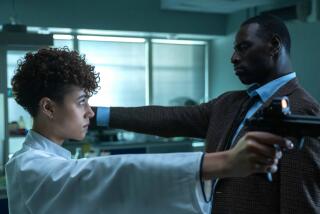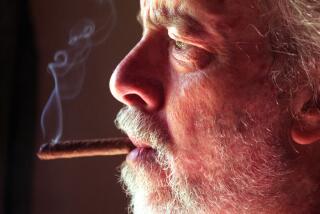Secret life of Johnnie To
- Share via
In Hong Kong, he is one of the most respected action directors, an inheritor of John Woo’s mantle, known for wild roller-coast rides of violence. In person, Johnnie To is a staid, somewhat heavyset man with wire-rimmed glasses, and neatly dressed in a light blue shirt, dark blue blazer and khaki slacks. Someone like director Tsui Hark (“Once Upon a Time in China,” “Double Team”), with his intense deep-set eyes and goatee, looks like a cinema legend, but more often than not, Hong Kong filmmakers tend to look like To (pronounced “toe”), accountants who don’t get enough sun or exercise.
But, ah, the fantasy life accountants must have!
Sitting in the conference room of a mid-city Los Angeles office, To is trying to speak English, his second language, sometimes reverting to phrases of Cantonese, but he’s determined to try to talk up his last film, “Fulltime Killer,” a multilingual shoot-’em-up fest, his first to have a general commercial release in the U.S. (It opens Friday in Los Angeles.
The film has a Wild West premise: A trigger-happy young assassin, Tok (Andy Lau), has decided to challenge the No. 1 hit man for the mob (known as the triad) in Asia, O (Takashi Sorimachi), a laconic Japanese man based in Hong Kong. But instead of having a simple shootout in a saloon or on main street like those American westerns, the action careens through several Asian cities as well as the colorful streets of Hong Kong -- colorful especially as they become blood-stained with carnage. The two killers also end up sharing a girlfriend, Chin (Kelly Lin), a befuddled video-store clerk who had been desperate to get away from her life of monotony; she gets her wish in twisted spades.
In one scene, Tok excuses himself from a coffee-shop date with her, dons a rubber Bill Clinton mask and walks to the car that contains his next victim -- presumably a triad boss. Taking out his shotgun, he dispatches three henchmen, then blows off the knees of the fleeing triad honcho, before finishing him off.
Is this film a bit too ... violent?
“Oh, not too much,” To says calmly in his deep, rumbly voice. “I’ve tried to shoot the violent scenes from a more romantic point of view. In the book there are very detailed scenes of getting rid of a corpse, but we shot that quite quickly.”
Referring to a final shootout in a warehouse stacked high with cardboard boxes of fireworks that go off, bursting in air, To says proudly, “Look at the ending, we shot it in quite a glorious way.”
Indeed, there are a lot of slo-mos, extreme close-ups and other fancy camerawork by cinematographer Cheng Siu Keung, along with daredevil Hong Kong stunts and just a few computer-generated images.
Like many in the Hong Kong film business, both in front of and behind the camera, To, 48, got his start by joining a Hong Kong television station, where he stayed from the 1970s through 1992, working his way up to assistant director, then director of serial dramas. “Many TV directors want to become film directors,” he says, because each series has “about three or four directors, following the story; you have no creative control. Everything is mechanical.”
His shift to features was gradual. His first was a martial arts flick, “The Enigmatic Case,” released in 1980. There was a long break; then, starting in 1986, he made three films for a prolific new production company, Cinema City, three popular comedies including “Eighth Happiness,” which was such a box office hit that To finally got the chance to make a film in which he had more input into the script, “The Story of Ah Long,” a family melodrama starring Chow Yun-Fat and Sylvia Chang. The director is flatly realistic about the Hong Kong movie business: “If I didn’t make money, they would not let me make movies I wanted to make.”
His first contemporary action adventure was “The Heroic Trio” in 1993 -- a novelty because the trio was female. A kind of comic-book style superhero saga starring Michelle Yeoh, Anita Mui and Maggie Cheung, the film evolved from a typically practical consideration.
“Why we shot this movie was because famous actors at that time were very expensive -- actors like Jet Li and Leslie Cheung,” To says. Those actors were commanding about half a million per film, a fortune when even an action film can be shot for less than $2 million.
But he admits, “We were not very successful. It wasn’t a period drama, it wasn’t a police thriller. We were ahead of our time.” The movie flopped at the box office.
Creative liberties
“Fulltime Killer” was based on a popular Hong Kong novel by Edmond Pang. Actor Andy Lau bought the rights and asked To to make it into a movie.
After selecting Sorimachi as the other lead, To let him choose the part he wanted, and he chose O, so Lau got to play Tok. The director agrees it’s a little bit of casting against type, since Lau plays the “showoff” character, not his usual public persona. To is proud of how they changed the novel. The screenplay is by his longtime collaborator, Wai Ka Fai, who’s also given a co-director credit, and Joseph O’Bryan, an American they hired when they thought they would make the film in English. (They eventually decided against it.)
“The novel focuses on the details of being a killer,” says Shan Ting, assistant director of To’s company, Milkyway Image. “So the novel was written almost like a diary. Secondly, the novel wasn’t set in all of Asia, only in Hong Kong.” They wanted to expand the geography, so they added location shooting in Japan, Singapore, Thailand and Macao.
The book also had a lot of references to popular movies, such as “Leon,” To says. “Tok would copy what killers did in movies, but we cut back on that and changed it to an occasional reference in the voice-over. After all, the fun part of making a film is the creative part -- the stuff you get to make up yourself. Like the final face-off in the warehouse, with Tok and O blasting away at each other from behind columns of boxes and fireworks being set off.
“It was all real,” To adds. So real that some boxes caught on fire, and crewmen tried to put it out by throwing a mattress over it. But since the mattress was foam rubber, it started burning too, and To rushed forward to remove the mattress, burning his arm so badly he had to be sent to the hospital for dressings. “We could have done it even better,” he says with a note of disappointment, “but after I went to the hospital ... well, we couldn’t continue shooting that scene.”
The director makes two to four films a year, although his newest, “P.T.U.” (Police Tactical Unit), recently shown at the Berlin International Film Festival to some acclaim, had to be shot over two years; it was perceived to be less commercial, so To had to make it during his down time.
All of which means he’s very much in demand. In fact, here he gives a little chuckle. While they were shooting “Fulltime Killer,” they were also shooting “Love on a Diet,” a wacky comedy with Andy Lau playing a very fat man. That, To adds, was a big box office hit.
Doesn’t he get exhausted with such a schedule?
“Yeah,” he says with a smile. “But the investors just want to make more movies.”
More to Read
Only good movies
Get the Indie Focus newsletter, Mark Olsen's weekly guide to the world of cinema.
You may occasionally receive promotional content from the Los Angeles Times.










